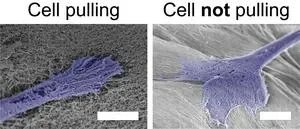(Press-News.org) May 3, 2024—CHICAGO—The American Ornithological Society (AOS) is pleased to announce Judit K. Szabo, Ph.D., as the incoming editor-in-chief for its top-ranked journal, Ornithological Applications. Beginning on May 1, 2024, Szabo will work in partnership with the journal’s current editor-in-chief, Catherine Lindell, Ph.D., until June 30, 2024, and will take on full responsibility as editor-in-chief beginning on July 1, 2024. “With her international interest and network, conservation experience, and thoughtful approach to editorial teamwork, Judit brings a great skill set to Ornithological Applications. I look forward to working with her,” Lindell says.
Szabo, Adjunct Research Fellow at Charles Darwin University, is a conservation biologist and ornithologist who previously served as an associate editor of Bird Conservation International for 11 years; as Editor-in-Chief of Avian Conservation and Ecology for three years; as Science Editor of Stilt for four years; and as a regular reviewer of many top ornithological and conservation biology journals for decades. “This is a humbling opportunity to carry the legacy of Ornithological Applications and make science available to inform on-the-ground conservation and management of birds,” Szabo says of her new appointment. “I am most excited about sharing my enthusiasm, professionalism, and international experience with readers of Ornithological Applications,” she adds. She joins a strong AOS editorial team that includes Ornithology editor-in-chief Christina P. Riehl, Ph.D., and a cadre of senior and associate editors from both AOS journals.
Szabo received a master’s degree in ecology from the University of Szeged, Hungary, in 1999, and her doctorate in ecotoxicology from Texas Tech University in 2006, studying the effects of pesticides on Australian birds. She was a postdoctoral fellow at the University of Wollongong and the University of Queensland, and a research fellow at Charles Darwin University in Australia, where she is currently Adjunct Research Fellow.
During her academic career, Szabo has studied optimal monitoring of birds, including threatened species. She contributed to the Red List assessment to determine the threat of extinction of all Australian bird species and subspecies and co-authored the Action Plan for Australian Birds 2010. She worked outside academia for the conservation of migratory waterbirds and their habitats in the East Asian–Australasian Flyway, as well as on policy capacity building of non-governmental organizations in Africa and Asia. Since 2018, Szabo has been working in Brazil. Her current interests include analyzing volunteer-collected datasets to unravel patterns and trends in bird distributions. Since 2014, she has been the Chair of the International Ornithological Union Research Coordination Committee on Bird Marking and also led several field courses to train people in bird banding around the world. She has banded and surveyed birds around the world, including Australia, Brazil, Costa Rica, Israel, Hungary, South Korea, Spain, Venezuela, and the U.S. She also has a keen interest in academic editing and translating.
Szabo has loved birds and other animals since childhood; her earliest memories are of rescuing mole crickets from her mother’s garden. Her birdwatching journey began at the age of 13, when she began going out on birdwatching and bird banding weekend trips with a local group. “Since my earliest memories as a child, I have always loved all kinds of birds,” she shares. “My current favorites are a couple of Bananaquits and four or five regular Swallow-tailed Hummingbirds who—for years—are trying to figure out who is the boss of the hibiscus plants flowering in my window.” When asked how she hopes to inspire future generations of ornithologists, she turned the question around, stating, “It is the enthusiasm of the young ornithologists I meet that gives me inspiration!”
Szabo’s enthusiasm for birds is clearly contagious. When she first met her husband, she says, “he knew about five different bird species. Now he can tell overflying parrots by the call and we have to stop and adore every Chalk-browed Mockingbird we see (his favorite bird).”
Follow Szabo’s research through her ORCID-ID.
About the Journal
Ornithological Applications is an international, scientific journal of the American Ornithological Society (the other is Ornithology). The journal publishes original research, syntheses, and assessments from all parts of the globe focusing on the application of scientific theory, ornithological knowledge, and methods to the conservation and management of birds, and to policy.
First published in 1899 by the Cooper Ornithological Society as The Bulletin of the Cooper Ornithological Club, the journal was renamed in 1900 to The Condor: A Magazine of Western Ornithology, and later still (1947) to The Condor: Journal of the Cooper Ornithological Club. In 2021, it became Ornithological Applications, currently one of two of the world’s foremost ornithological journals published by the American Ornithological Society.
###
END
The American Ornithological Society (AOS) names Judit Szabo as new Ornithological Applications editor-in-chief
2024-05-03
ELSE PRESS RELEASES FROM THIS DATE:
Catheter-directed mechanical thrombectomy system demonstrates safety and effectiveness in patients with pulmonary embolism
2024-05-03
Long Beach, Calif. – May 3, 2024 – New data from the Acute Pulmonary Embolism Extraction Trial with the AlphaVac System (APEX-AX) demonstrated that catheter-directed mechanical thrombectomy is safe and effective in patients with acute intermediate-risk pulmonary embolism (PE) with significant improvement in the right ventricle (RV) function and minimal major adverse events. The safety and efficacy results from the prospective trial were presented today as late-breaking science at the Society for Cardiovascular Angiography & Interventions (SCAI) 2024 Scientific Sessions.
Pulmonary embolism (PE), a blood clot that blocks and stops ...
Novel thrombectomy system demonstrates positive safety and feasibility results in treating acute pulmonary embolism
2024-05-03
Long Beach, Calif. – May 3, 2024 – Late-breaking data from the ENGULF trial showed that a novel dual-action thrombectomy device was effective and safe in treating acute pulmonary embolism (PE). The safety and effectiveness results were presented today as late-breaking science at the Society for Cardiovascular Angiography & Interventions (SCAI) 2024 Scientific Sessions and simultaneously published in JSCAI.
PE is a serious cardiovascular event where a blood clot causes issues with blood flow and oxygen levels in the lungs. It can be ...
Biomimetic transcatheter aortic heart valve offers new option for aortic stenosis patients
2024-05-03
Long Beach, Calif. – May 3, 2024 – Recent findings from a study on a transcatheter heart valve (THV) system, which includes a new class of transcatheter aortic valve, showed positive results in the device's ability to function as a healthy and natural aortic valve in patients with aortic stenosis (AS). The late-breaking data will be presented today at the Society for Cardiovascular Angiography & Interventions (SCAI) 2024 Scientific Sessions.
AS is a thickening and narrowing of the aortic valve that can reduce blood flow to ...
SMART trial reaffirms hemodynamic superiority of TAVR self-expanding valve in aortic stenosis patients with a small annulus over time and regardless of age
2024-05-03
Long Beach, Calif. – May 3, 2024 – Additional analysis from the SMall Annuli Randomized To Evolut or SAPIEN (SMART) study demonstrated clinical non-inferiority of self-expanding valves (SEV) versus balloon-expandable valves (BEV) in aortic stenosis patients undergoing transcatheter aortic valve replacement (TAVR) and confirmed valve performance superiority over time based on hemodynamics. Data also showed similar positive results in two age groups (< or ≥ 80 years old). The late-breaking results were presented today at the Society for Cardiovascular Angiography & Interventions ...
Metastatic prostate cancer research: PSMAfore follow-on study favors radioligand therapy over change to androgen receptor pathway inhibition
2024-05-03
Study Title: Efficacy of [177Lu]Lu-PSMA-617 versus ARPI change in taxane-naive patients with metastatic castration-resistant prostate cancer by pre-randomization ARPI (PSMAfore)
Publication: American Urological Association Annual Meeting Plenary, May 3, 2024
Dana-Farber Cancer Institute author: Xiao X. Wei, MD
Summary: In a follow-on analysis of results from the phase 3 PSMAfore study, clinical investigators from Dana-Farber and elsewhere found that clinical outcomes consistently favored 177Lu-PSMA-617 over a change from one androgen receptor pathway inhibitor (ARPI) to another, regardless of which ARPI patients received first. ...
Studies highlight need for tailored treatment options for women with peripheral artery disease
2024-05-03
Late-Breaking Data Shows Endovascular Therapy Results in One-Third Reduction in Post-Procedural Complications for Women with PAD
Women and Asian Americans Less Likely to Undergo Endovascular Revascularization for PAD Compared to Men and Other Races
Long Beach, Calif. – May 3, 2024 – New clinical results highlight the need for inclusive approaches and comprehensive examinations of treatment options for peripheral artery disease (PAD), including endovascular therapy and revascularization. The data ...
Women and Black patients less likely to receive catheter-based treatment for pulmonary embolism
2024-05-03
Long Beach, Calif. – May 3, 2024 – New data from the REAL-PE analysis investigated catheter-based pulmonary embolism (PE) treatment, showing women and Black people were less frequently treated with minimally invasive therapy compared to men or non-Black patients. The late-breaking results were presented today at the Society for Cardiovascular Angiography & Interventions (SCAI) 2024 Scientific Sessions.
...
Pilot program improves well-being of families during advanced care planning
2024-05-03
WASHINGTON (May 3, 2024) – Children with life-limiting rare diseases and their caregivers face tremendous stress and anxiety about the heart-breaking decisions before them. A new intervention – designed at Children’s National Hospital to support the palliative needs of these families – improved their spiritual and emotional well-being, according to new research published in the journal, Pediatrics.
Called FACE Rare (FAmily CEntered Pediatric Advance Care Planning Intervention for Rare Diseases), the counseling tools were found to be safe, effective and increased feelings of peace among families in this underserved ...
The key role of Galectin-3 in brain tumour development
2024-05-03
A research group at the Department of Biochemistry and Molecular Biology of the University of Seville has made a significant advance by discovering the crucial role of the protein Galectin-3 in the progression of various types of brain tumours. In these tumours, the most abundant immune system cells, microglia and macrophages, overexpress Galectin-3, which creates an immunosuppressed environment which inhibits the action of other immune cells against cancer cells.
In vitro findings have shown that specific inhibition of Galectin-3 in microglial cells promotes expression of proinflammatory markers and reverses the presence of key immunosuppressive ...
Announcing Junevity as Tier 3 Sponsor of ARDD 2024
2024-05-03
The University of Copenhagen is excited to announce Junevity as a Tier 3 Sponsor of the 11th Aging Research & Drug Discovery Meeting, the world's largest conference on aging research in the biopharmaceutical industry that will transpire on August 26 - August 30, 2024 on-site at the Ceremonial Hall, University of Copenhagen, and online.
Junevity is rewinding diseases of aging with novel transcription factor medicines. Based on 6 years of breakthrough research at UCSF, Junevity's REWINDTM platform identifies new targets based on large-scale genomics, machine learning, and cell aging experiments. Junevity is advancing multiple therapeutic programs towards ...










